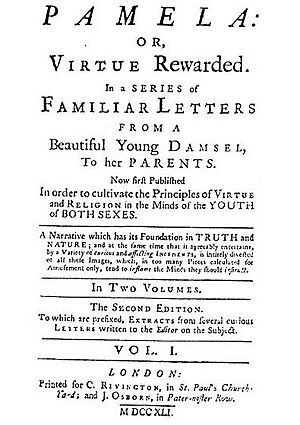Epistolary novel facts for kids
An epistolary novel is a special kind of novel. It tells a story using a series of letters or other documents. Think of it like reading someone's mail, diary, or even text messages! The word epistolary comes from an old Greek word, epistolē, which means "a letter."
This way of writing can make a story feel very real to you. It's like you're getting a personal look into the characters' lives. You read their thoughts and feelings directly, just as they wrote them down.
Contents
Famous Epistolary Novels

This is the title page of the second edition of Pamela; or, Virtue Rewarded (1740) by Samuel Richardson. It was a very popular early epistolary novel.
Epistolary novels have been popular for a long time. Many famous authors have used this style to tell their stories.
Books from the 1700s
- Lettres persanes (1721) by Montesquieu. This book tells a story through letters.
- Pamela; or, Virtue Rewarded (1740) by Samuel Richardson. This was a very popular early epistolary novel. It made many other writers want to try this style.
- Julie; or, The New Heloise (1761) by Jean-Jacques Rousseau.
- The Sorrows of Young Werther (1774) by Johann Wolfgang Goethe.
- Evelina (1778) by Frances Burney.
- Cartas marruecas (Moroccan Letters) (1789) by José Cadalso.
Books from the 1800s
- Frankenstein (1818) by Mary Shelley. This classic horror story uses letters to frame the main narrative. It's like a story inside a story, told through letters.
- Poor Folk (1846) by Fyodor Dostoevsky. This was Dostoevsky's first novel. It's a series of letters between two friends who are struggling with poverty in Russia.
- The Tenant of Wildfell Hall (1848) by Anne Brontë. This book is told through letters and diary entries.
- The Woman in White (1859) and The Moonstone (1868) by Wilkie Collins. The Moonstone is a detective novel told through different documents.
- Pepita Jiménez (1874) by Juan Valera.
- Dracula (1897) by Bram Stoker. This famous vampire story uses many different types of documents. It includes letters, diary entries, recordings, and even newspaper articles.
Books from the 1900s
- The Documents in the Case (1930) by Dorothy L. Sayers and Robert Eustace.
- Diary of a Provincial Lady (1930) by E.M. Delafield.
- Address Unknown (1938) by Kathrine Taylor. This novel is about the rise of the Nazi party. The last letter is returned marked "Address Unknown," showing the German character has disappeared.
- The Screwtape Letters (1942) by C. S. Lewis. This book is a series of letters from a senior demon to a junior demon. It gives advice on how to tempt humans.
- Ides of March (1948) by Thornton Wilder. This novel uses letters and documents to show the last days of the Roman Republic.
- Herzog (1964) by Saul Bellow. The main character, Moses Herzog, writes many letters, both real and imagined.
- Silence (1966) by Shūsaku Endō. This novel is partly told through letters.
- Flowers for Algernon (1966) by Daniel Keyes. This story is told through "progress reports" written by the main character. His writing style changes as his intelligence changes.
- Carrie (1974) by Stephen King. This horror novel uses newspaper clippings, magazine articles, letters, and book excerpts.
- The Color Purple (1982) by Alice Walker. This book is told through letters.
- The Handmaid's Tale (1985) by Margaret Atwood. This story ends with a section that explains the novel's text was found on old cassette tape recordings.
- Sorcery and Cecelia (1988) by Patricia Wrede and Caroline Stevermer. This is a fantasy novel told through letters between two cousins.
- Nothing but the Truth (1991) by Avi. This young adult novel uses only documents, letters, and conversation transcripts.
- The Perks of Being a Wallflower (1999) by Stephen Chbosky. This book is written as letters from an anonymous character.
Books from the 2000s
- Ella Minnow Pea (2001) by Mark Dunn. In this unique novel, letters of the alphabet are removed from the language as the story goes on. This makes the letters harder to read.
- La silla del águila (The Eagle's Throne) (2003) by Carlos Fuentes. This is a political story told through letters between Mexican government officials.
- We Need to Talk About Kevin (2003) by Lionel Shriver. This novel is a series of letters from a mother to her husband.
- Cloud Atlas (2004) by David Mitchell. This book tells stories from different time periods. Some parts are told through interviews, journal entries, and letters.
- March (2005) by Geraldine Brooks. This novel tells about the American Civil War through letters.
- World War Z: An Oral History of the Zombie War (2006) by Max Brooks. This book is a series of interviews with people who survived a zombie apocalypse.
- Salmon Fishing in the Yemen (2007) by Paul Torday. This book uses letters, emails, interviews, and newspaper articles.
- The White Tiger (2008) by Aravind Adiga. This novel is written as letters from an Indian villager to the Chinese Premier Wen Jiabao.
- The Guernsey Literary and Potato Peel Pie Society (2008) by Mary Ann Shaffer and Annie Barrows. This story is told through letters and telegrams.
- Where'd You Go, Bernadette (2012) by Maria Semple. This book is told through emails, memos, and transcripts.
- Illuminae by Jay Kristoff and Amie Kaufman. This science fiction novel is told completely through classified documents, censored emails, and interviews.
Images for kids
-
Title page of Aphra Behn's early epistolary novel, Love-Letters Between a Nobleman and His Sister (1684)
See also
 In Spanish: Novela epistolar para niños
In Spanish: Novela epistolar para niños

All content from Kiddle encyclopedia articles (including the article images and facts) can be freely used under Attribution-ShareAlike license, unless stated otherwise. Cite this article:
Epistolary novel Facts for Kids. Kiddle Encyclopedia.

